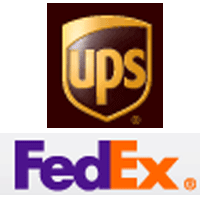
New e-commerce strategies threaten UPS, FedEx

 UPS and FedEx might be worried about international shipments to slowing economies like China, but perhaps they should be more concerned about what's going on in their own back yards.
UPS and FedEx might be worried about international shipments to slowing economies like China, but perhaps they should be more concerned about what's going on in their own back yards.
Major U.S. retailers are experimenting with new e-commerce strategies that could dent demand for package delivery services, particularly demand for shipments over long distances, according to analysts and industry executives.
Amazon.com Inc is building its distribution warehouses closer to customers to save millions of dollars in shipping costs. The world's largest online retailer is also increasingly using its own delivery trucks, cutting UPS and FedEx out of some parts of its fulfillment network.

Meanwhile, major brick-and-mortar retailers such as Wal-Mart Stores Inc, Best Buy Co Inc and Gap Inc are shipping more online orders from stores close to shoppers, rather than from warehouses hundreds of miles away.
"UPS and FedEx are not only watching this, they are likely concerned about it," said Lou Tapper, an executive at third-party logistics company Longistics, who worked at FedEx for 18 years. "Big companies like Amazon and Wal-Mart will dictate which direction this goes. Those are the companies that FedEx and UPS need to fill their planes and trucks."
United Parcel Service Inc, the world's largest package delivery company, on Friday cut its earnings forecasts, blaming overcapacity in the global air freight market, customers trading down to slower but cheaper shipping services, and a slowing U.S. industrial economy.

The move came after FedEx Corp said in June that it was raising shipping rates and cutting jobs and costs, as excess capacity in the air freight market had more than offset increased shipments.
Both package delivery companies set their fees according to zones that correspond to the distance a package has to travel.
For instance, FedEx's Zone 2 is zero-to-150 miles from origin to destination, while Zone 4 is 301-to-600 miles. Shipping a 10-pound package in two days through Zone 4 costs $25.80, while the same package in Zone 2 costs 32 percent less at $17.50, according to FedEx's latest rate card for consumers.

UPS uses similar zones for its domestic ground delivery service, which takes four to five days. Zone 4 costs $9.20, while Zone 2 costs $7.94 for a 10-pound package.
Retail companies get discounts for shipping big volumes of goods, but the percentage differences between the zones are similar, according to Joel Anderson, president of walmart.com.
Wal-Mart, the world's largest retailer, has been shipping online orders from its stores for several years. This year, it is expanding the program to 50 locations from 25.

"We are at least two zones closer by utilizing the stores," Anderson said. "The closer we can inject the order into our network, the more this saves the customer time and reduces what it will cost us to get it to the customer."
He declined to say how much Wal-Mart is saving from this.
To be sure, ship-from-store retail initiatives can also benefit package delivery companies if they accelerate the growth of online shopping - even if delivery distances are shorter.

UPS spokesperson Susan Rosenberg said the company is benefiting from the spread of e-commerce distribution centers built by Amazon and other companies. UPS also helps retailers ship online orders from stores, she added.
FedEx did not respond to requests for comment on Friday.
"If I buy a shirt from Gap online, the shipping route length may be shorter, but then more people are buying online too," said analyst Joshua Herrity of Telsey Advisory Group.

Still, the risks that these retail strategies pose to package delivery companies are beginning to be discussed on Wall Street. The topic came up during a UPS conference call with analysts in April.
"Some of the questions I get asked...are whether these same retailers are going to try to build a network that doesn't incorporate the current parcel carriers in ways that they could actually end up being a competitor," Morgan Stanley analyst Bill Greene said during the call.
Ship from store may be a problem for UPS and FedEx in five to 10 years, but it will take some time for lots of retailers to figure how to make the strategy work well at high volumes, according to Fiona Dias, chief strategy officer at ShopRunner.
A more immediate threat is Amazon, Dias and others said.
Amazon has a growing fleet of delivery trucks, which are already a common sight in its home town of Seattle, where it has been operating an online grocery delivery service for years.
In 2011, Amazon changed its fulfillment strategy and began building new distribution warehouses closer to large, heavily populated areas such as Los Angeles and San Francisco.
In the first quarter of 2013, Amazon's shipping costs were 4.7 percent of revenue, down from 5.1 percent a year earlier.
"For a company the size of Amazon, that's a pretty big deal," said R.J. Hottovy, an equity analyst at Morningstar.
"That could be potentially very disruptive to UPS and FedEx," he added.
